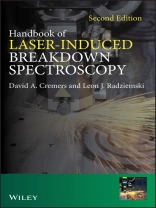Starting from fundamentals and moving through a thorough
discussion of equipment, methods, and techniques, the Handbook
of Laser-Induced Breakdown Spectroscopy provides a unique
reference source that will be of value for many years to come for
this important new analysis method. The authors, with a total
of over 60 years of experience in the LIBS method, use a
combination of tutorial discussions ranging from basic principles
up to more advanced descriptions along with extensive figures and
photographs to clearly explain topics addressed in the text. In
this second edition, chapters on the use of statistical analysis
and advances in detection of weapons of mass destruction have been
added. Tables of data related to analysis with LIBS have been
updated.
The Handbook of Laser-Induced Breakdown Spectroscopy, Second
Edition:
* provides a thorough but understandable discussion of the basic
principles of the method based on atomic emission spectroscopy,
including recently available data leading to better
characterization of the LIBS plasma;
* presents a discussion of the many advantages of the method
along with limitations, to provide the reader a balanced overview
of capabilities of the method;
* describes LIBS instrumentation ranging from basic set-ups to
more advanced configurations;
* presents a comprehensive discussion of the different types of
components (laser, spectrometers, detectors) that can be used for
LIBS apparatuses along with suggestions for their use, as well as
an up-to-date treatment of the newest advances and capabilities of
LIBS instruments;
* presents the analytical capabilities of the method in terms of
detection limits, accuracy, and precision of measurements for a
variety of different sample types;
* discusses methods of sampling different media such as gases,
liquids, and solids;
* presents an overview of some real-world applications of the
method, with new emphasis on sampling of biologically and
physically dangerous materials;
* provides an up-to-date list of references to LIBS literature
along with the latest detection limits and a unique list of element
detection limits using a uniform analysis method;
* provides annotated examples of LIBS spectra which can serve as
references for the general reader and will be especially useful for
those starting out in the field.
Tabla de materias
Preface xi
Acronyms, Constants, and Symbols xv
1 Introduction 1
1.1 Atomic Optical Emission Spectrochemistry (OES) 1
1.2 Laser-Induced Breakdown Spectroscopy (LIBS) 2
1.3 LIBS History 1960-1980 7
1.4 LIBS History 1981-1990 9
1.5 LIBS History 1991-2000 11
1.6 LIBS History 2001-2012 14
References 18
2 Basics of the LIBS Plasma 29
2.1 LIBS Plasma Fundamentals 29
2.2 Laser-Induced Breakdown 46
2.3 Laser Ablation from Surfaces and Aerosols 53
2.4 Nanosecond and Femtosecond Double- or Multiple-Pulse LIBS58
2.5 Summary 63
2.6 Problems 63
References 64
3 LIBS Apparatus Fundamentals 69
3.1 Basic LIBS Apparatus 69
3.2 Lasers 70
3.3 Optical Systems 80
3.4 Methods of Spectral Resolution 86
3.5 Detectors 102
3.6 Detection System Calibrations 109
3.7 Timing Considerations 114
3.8 Methods of LIBS Deployment 115
3.9 Problems 117
References 118
4 LIBS Analytical Figures of Merit and Calibration123
4.1 Introduction 123
4.2 Basics of a LIBS Measurement 123
4.3 Precision 129
4.4 Calibration 131
4.5 Detection Limit 144
4.6 Accuracy 144
4.7 Problems 146
References 148
References for Detection Limits 150
5 Qualitative LIBS Analysis 151
5.1 Introduction 151
5.2 Identifying Elements 151
5.3 Material Identification 156
5.4 Process Monitoring 159
5.5 Material Sorting/Distinguishing 169
5.6 Site Screening Using LIBS 177
5.7 Semiquantitative Analysis 178
5.8 Problems 180
References 182
6 Quantitative LIBS Analysis 185
6.1 Introduction 185
6.2 Effects of Sampling Geometry 185
6.3 Other Sampling Considerations 189
6.4 Incomplete Vaporization and Ablation Stoichiometry 193
6.5 Use of Internal Standardization 194
6.6 Chemical Matrix Effects 196
6.7 Example of LIBS Measurement: Impurities in Lithium-Containing Solutions 198
6.8 Example of LIBS Measurement: Detection of Materials on Swipes 206
6.9 Reported Figures of Merit for LIBS Measurements and Comparison with Standard Methods 211
6.10 Enhancing Quantitative Analysis via Sophisticated Signal Processing 219
6.11 Conclusions 220
References 221
7 Chemometric Analysis in LIBS 223
7.1 Introduction 223
7.2 Chemometric Terms 227
7.3 Chemometric Analysis/Model Development 232
7.4 Summary 241
References 241
8 Remote LIBS Measurements 257
8.1 Introduction 257
8.2 Conventional Open-Path LIBS 259
8.3 Standoff LIBS Using Femtosecond Pulses 270
8.4 Fiber Optic LIBS 276
References 284
9 Selected LIBS Applications 289
9.1 Introduction 289
9.2 LIBS and the CBRNE Threats 289
9.3 LIBS Analysis of Liquids and Solids in Liquids 297
9.4 Transportable LIBS Instrument for Stand-off Analysis 303
9.5 LIBS for Space Applications 313
References 325
A Safety Considerations in LIBS 333
B Major LIBS References 337
C Detection Limits from the Literature 341
D Examples of LIBS Spectra 377
E Solutions to Problems 387
Index 397
Sobre el autor
David A. Cremers, Applied Research Associates Inc, Albuquerque, NM, USA
Leon J. Radziemski , Tucson, AZ, USA












